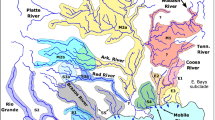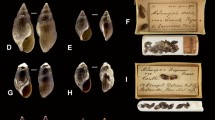Abstract
We provide mitochondrial sequence variation of the invasive fish Gambusia holbrooki from 24 European populations, from Portugal to Greece. Phylogeographic structure in Europe was compared with genetic data from native samples (USA) and historical records were reviewed to identify introduction routes. Overall, data agree with records of historical introductions and translocations, and indicate that the most abundant haplotype throughout Europe originated from North Carolina and corresponded to the first introduction in 1921 to Spain, being transferred to Italy in 1922 and to many countries afterwards. Our results also show that at least another independent introduction occurred first in France and subsequently from France to Greece. Haplotypes of G. affinis were not detected in our European sampling effort but historical records and other data suggest that this species was introduced to Italy in 1927 and it might be present. At the continental scale, there is less diversity in Europe than in North America, in agreement with the low number of introduced fish. At the local scale, some European populations gained diversity from multiple introductions and from “de novo” mutations.



Similar content being viewed by others
References
Alcaraz C, Bisazza A, García-Berthou E (2008) Salinity mediates the competitive interactions between invasive mosquitofish and an endangered fish. Oecologia 155:205–213
Allendorf FW, Lundquist LL (2003) Introduction: population biology, evolution, and control of invasive species. Conserv Biol 17:24–30
Anonymous (1927) Introduzione della “Gambusia patruelis” in Italia. Riv Malariol 6:999-1000
Artom C (1924) La specie di Gambusia acclimatata in Italia (Gambusia holbrooki Grd) in relazione colla stabilità del carattere del gonopodio. Atti Acc Naz Lincei 33:278–282
Bandelt H-J, Forster P, Röhl A (1999) Median-joining networks for inferring intraspecific phylogenies. Mol Biol Evol 16:37–48
Benejam L, Alcaraz C, Sasal P, Simon-Levert G, García-Berthou E (2009) Life history and parasites of the invasive mosquitofish (Gambusia holbrooki) along a latitudinal gradient. Biol Invasions. doi:10.1007/s10530-008-9413-0
Congdon BC (1994) Salinity-related fitness differences amongst GPI genotypes in the mosquitofish Gambusia holbrooki (Poeciliidae: Teleostei). Biol J Linn Soc 53:343–352
Congdon BC (1995) Unidirectional gene flow and maintenance of genetic diversity in the mosquitofish Gambusia holbrooki (Teleostei: Poeciliidae). Copeia 1995:162–172
Courtenay WR Jr, Meffe GK (1989) Small fishes in strange places: a review of introduced poeciliids. In: Meffe GK, Snelson FF (eds) Ecology and evolution of livebearing fishes (Poeciliidae). Englewood Cliffs, New Jersey, pp 319–331
Davis SK, Echelle AA, Van Den Bussche RA (2006) Lack of cytonuclear genetic introgression despite long-term hybridization and backcrossing between two poeciliid fishes (Gambusia heterochir and G. affinis). Copeia 2006:351–359
Dlugosch KM, Parker IM (2008) Founding events in species invasions: genetic variation, adaptive evolution, and the role of multiple introductions. Mol Ecol 17:431–449
Ekmekçi FG, Kirankaya ŞG (2006) Distribution of an invasive fish species, Pseudorasbora parva (Temminck & Schlegel, 1846) in Turkey. Turk J Zool 30:329–334
Estoup A, Largiadier CR, Perrot E, Chourrout D (1996) Rapid one-tube DNA extraction for reliable PCR detection of fish polymorphic markers and transgenes. Mol Mar Biol Biotechnol 5:295–298
Excoffier L, Laval G, Schneider S (2005) Arlequin ver. 3.0: An integrated software package for population genetics data analysis. Evol Bioinform Online 1:47–50
Facon B, Pointier JP, Jarne P, Sarda V, David P (2008) High genetic variance in life-history strategies within invasive populations by way of multiple introductions. Curr Biol 18:363–367
Felsenstein J (1985) Confidence limits on phylogenies: an approach using the bootstrap. Evolution 39:783–791
García-Berthou E, Alcaraz C, Pou-Rovira Q, Zamora L, Coenders G, Feo C (2005) Introduction pathways and establishment rates of invasive aquatic species in Europe. Can J Fish Aquat Sci 62:453–463
Grapputo A, Bisazza A, Pilastro A (2006) Invasion success despite reduction of genetic diversity in the European populations of eastern mosquitofish (Gambusia holbrooki). Ital J Zool 73:67–73
Hall TA (1999) BioEdit: A user-friendly biological sequence alignment editor and analysis program for Windows 95/98/NT. Nucleic Acids Symp Ser 41:95–98
Haynes JL, Cashner RC (1995) Life-history and population-dynamics of the western mosquitofish: a comparison of natural and introduced populations. J Fish Biol 46:1026–1041
Hrbek T, Seckinger J, Meyer A (2007) A phylogenetic and biogeographic perspective on the evolution of poeciliid fishes. Mol Phylogenet Evol 43:986–998
Innal D, Erk’akan F (2006) Effects of exotic and translocated fish species in the inland waters of Turkey. Rev Fish Biol Fisheries 16:39–50
Kats LB, Ferrer RP (2003) Alien predators and amphibian declines: review of two decades of science and the transition to conservation. Divers Distrib 9:99–110
Kolbe JJ, Glor RE, Rodriguez SL, Lara AC, Larson A, Losos JB (2004) Genetic variation increases during biological invasion by a Cuban lizard. Nature 431:177–181
Krumholz LA (1948) Reproduction in the western mosquitofish, Gambusia affinis affinis (Baird & Girard), and its use in mosquito control. Ecol Monogr 18:1–43
Lee CE (2002) Evolutionary genetics of invasive species. Trends Ecol Evol 17:386–391
Lydeard C, Wooten MC, Meyer A (1994) Cytochrome b sequence variation and a molecular phylogeny of the live-bearing fish genus Gambusia (Cyprinodontiformes: Poeciliidae). Can J Zool 73:213–227
Mulvey M, Newman MC, Chazal A, Keklak MM, Heagler MG, Hales LJ (1995) Genetic and demographic responses of mosquitofish (Gambusia holbrooki Girard 1859) populations stressed by mercury. Environ Toxicol Chem 14:1411–1418
Nájera Angulo L (1944) Sobre la identificación de la Gambusia holbrookii. Bol R Soc Esp Hist Nat Biol 42:51–55
Nei M (1987) Molecular evolutionary genetics. Columbia University Press, New York, p 512
Pyke GH (2008) Plague minnow or mosquito fish? A review of the biology and impacts of introduced Gambusia species. Ann Rev Ecol Syst 39:171–191
Rauchenberger M (1989) Systematics and biogeography of the genus Gambusia (Cyprinodontiformes: Poeciliidae). Am Mus Novit 2951:1–74
Rice JA, Sax DF (2005) Testing fundamental evolutionary questions at large spatial and demographic scales: species invasions as an underappreciated tool. In: Sax DF, Stachowicz JJ, Gaines SD (eds) Species invasions: insights into ecology, evolution, and biogeography. Sinauer Associates, Sunderland, pp 291–308
Roman J, Darling JA (2007) Paradox lost: genetic diversity and the success of aquatic invasions. Trends Ecol Evol 22:454–464
Saitou N, Nei M (1987) The neighbor-joining method: a new method for reconstructing phylogenetic trees. Mol Biol Evol 4:406–425
Sax DF, Brown JH (2000) The paradox of invasion. Global Ecol Biogeogr 9:363–371
Scribner KT (1993) Hybrid zone dynamics are influenced by genotype-specific variation in life-history traits: experimental evidence from hybridizing Gambusia species. Evolution 47:632–646
Scribner KT, Avise JC (1993) Cytonuclear genetic architecture in mosquitofish populations and the possible roles of introgressive hybridization. Mol Ecol 2:139–149
Scribner KT, Avise JC (1994) Population cage experiments with a vertebrate: the temporal demography and cytonuclear genetics of hybridization in Gambusia fishes. Evolution 48:155–171
Sella M (1926) Pesci larvifagi. Riv Malariol 5:504–507
Sella M (1929) Gambusia e verde Parigi nella lotta antimalarica a Rovigno e cenni sulla lotta in Istria. Riv Malariol 8:357–392
Stearns SC (1983) The genetic basis of differences in life-history traits among six populations of mosquitofish (Gambusia affinis) that shared ancestors in 1905. Evolution 37:618–627
Suarez AV, Tsutsui ND (2008) The evolutionary consequences of biological invasions. Mol Ecol 17:351–360
Tamura K, Nei M (1993) Estimation of the number of nucleotide substitutions in the control region of mitochondrial DNA in humans and chimpanzees. Mol Biol Evol 10:512–526
Tamura K, Dudley J, Nei M, Kumar S (2007) MEGA4: molecular evolutionary genetics analysis (MEGA) software version 4.0. Mol Biol Evol 24:1596–1599
Veenvliet P (2007) Species identity of Gambusia (Pisces: Poeciliidae) introduced to Slovenia. Natura Sloveniae 9:43–46
Walters DM, Freeman BJ (2000) Distribution of Gambusia (Poeciliidae) in a southeastern river system and the use of fin ray counts for species determination. Copeia 2000:555–559
Wooten MC, Lydeard C (1990) Allozyme variation in a natural contact zone between Gambusia affinis and Gambusia holbrooki. Biochem Syst Ecol 18:169–173
Wooten MC, Scribner KT, Smith MH (1988) Genetic variability and systematics of Gambusia in the southeastern United States. Copeia 1988:283–289
Acknowledgments
We are grateful to everybody who sent mosquitofish samples from many places or helped us to sample mosquitofish, particularly C. Alcaraz, J. Cucherousset, A. Echelle, C. Fruciano, C. Genas, L. Santos, A. Specziar, F. Maltagliati, M.T. Ferreira, P. Schofield, M. Th. Stoumboudi, R. Arndt and F. Rohde. We also thank anonymous reviewers for helpful comments on the manuscript. This study was financially supported by the Spanish Ministry of Education (CGL2006-11652-C02-02/BOS) and the Government of Catalonia (Catalan Government Distinction Award for University Research 2004 to EGB).
Author information
Authors and Affiliations
Corresponding author
Rights and permissions
About this article
Cite this article
Vidal, O., García-Berthou, E., Tedesco, P.A. et al. Origin and genetic diversity of mosquitofish (Gambusia holbrooki) introduced to Europe. Biol Invasions 12, 841–851 (2010). https://doi.org/10.1007/s10530-009-9505-5
Received:
Accepted:
Published:
Issue Date:
DOI: https://doi.org/10.1007/s10530-009-9505-5




